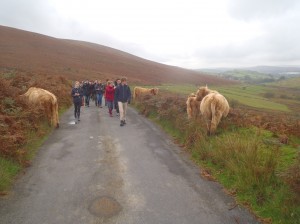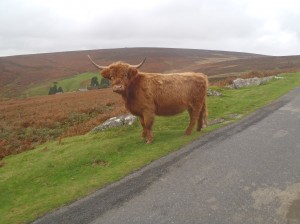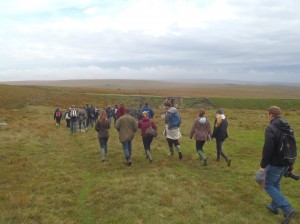Reading Howard’s refelctions of his Dartmoor visit last weekend reminded me of my recent field trip with some of my final year undergraduates last October: The weather forecast was atrocious, with bands of heavy rain sweeping across the south west, getting heavier in the afternoon. As it turned out, things started off grey and cloudy, but cleared up after lunch with the sunshine helping to take the edge off the keen SSE winds. We headed off from Bennett’s Cross, leaving the coach behind to go over Birch Tor, and on to Hookney Tor.
We came across a very docile group of ‘Highland’ Cattle, acting as key ‘countryside curators’, managing the land to maintain a desired look and feel of this National landscape. After a stop at Grimspound and Headland Warren, we walked back towards the coach through the old industrial areas of Golden Dagger, Vitifer and Birch Tor mines – and could make out (vaguely) some of the shapes of the Devil’s Playing Cards – and it struck me that the it was almost exactly 375 years to the day since (legend has it) these ‘Devilish enclosures’ got their name….
Sunday 21st October 1638 was stormy day, with heavy rain and strong winds. While some locals were gathered at the Tavistock Inn at Poundsgate, the Devil came in for a swift half – they knew it was the Devil, since he had cloven hooves, and he paid for his pint using ‘solid gold coins’ that turned to dry leaves as soon as he left! Other locals sheltered from the storm in the church in Widecombe-in-the-Moor – these included Jan Richards, a well-known local gambler who was playing cards at the back of the church. All of a sudden, the Devil struck – he smashed through the roof of the church and plucked Jan Richards from his pew. Poor old Jan was carried over the hills, never to be seen again – except that he dropped his playing cards: 4 aces that he’d hidden up his sleeve. These 4 aces landed on the hillside between Challacombe and the Warren House Inn, and can still be seen to this day – as 4 small enclosures that are (very roughly) in the shape of the 4 suits of a pack of cards.
This is a nice story – various versions of which can be found, repeated in several ‘folk tale’ books and websites about Dartmoor. Of course, it isn’t ‘true’ – the 4 enclosures might be physical present, but they cannot be the remnants of a pack of cards. And of course the story of the Devil, smashing his way in to Widecombe Church is just a fairy tale – right?
Sunday 21st October 1638 was stormy day, with heavy rain and strong winds. Many locals sheltered from the storm in the church in Widecombe-in-the-Moor. All of a sudden, the church roof comes crashing down, as a pinnacle from one of the towers topples and smashes through the ancient roof of the nave. The falling debris kills 4 people, including the head warrener from the rabbit farms close to Warren House Inn. This is all recorded in the church records, and is one of the earliest archival records of what is thought to be ball lightening – as a very real ‘thunder bolt’ strikes one of the pinnacles of Widecombe church, sending it crashing through the roof onto the parishioners below.
Here we see a nice example of how ‘real memory’ and ‘folk memory’ can come together through an invocation of landscape; oral histories used to account for the physical artefacts of landscape enclosures – 4 small distinct enclosures acting as a totem through which an important event of folk memory can be prompted, instilled and legitimated: folk memories of extraordinary events, working alongside an everyday requirement to make sense of the landscape, as a commonplace and non-elite space. At very least there seems to be ‘some truth’ in the folk tales of the Devil wreaking havoc at Widecombe church. By giving more credence to the “extra-ordinary” possibilities and experiences of how ordinary people engage with the world around them, however, maybe it is possible to see the story of the Devil’s Playing Cards as providing an authentic means through which to understand how heritage works? Indeed, when placed within the context of the religious upheavals of the mid-seventeenth century, the ‘real’ possibility of devilish intervention in peoples’ lives, and of the possibility of direct experience of ‘evil’, then it could be argued that the story of the Devil paying a visit to Widecombe represents the ‘whole truth’ of the matter.



